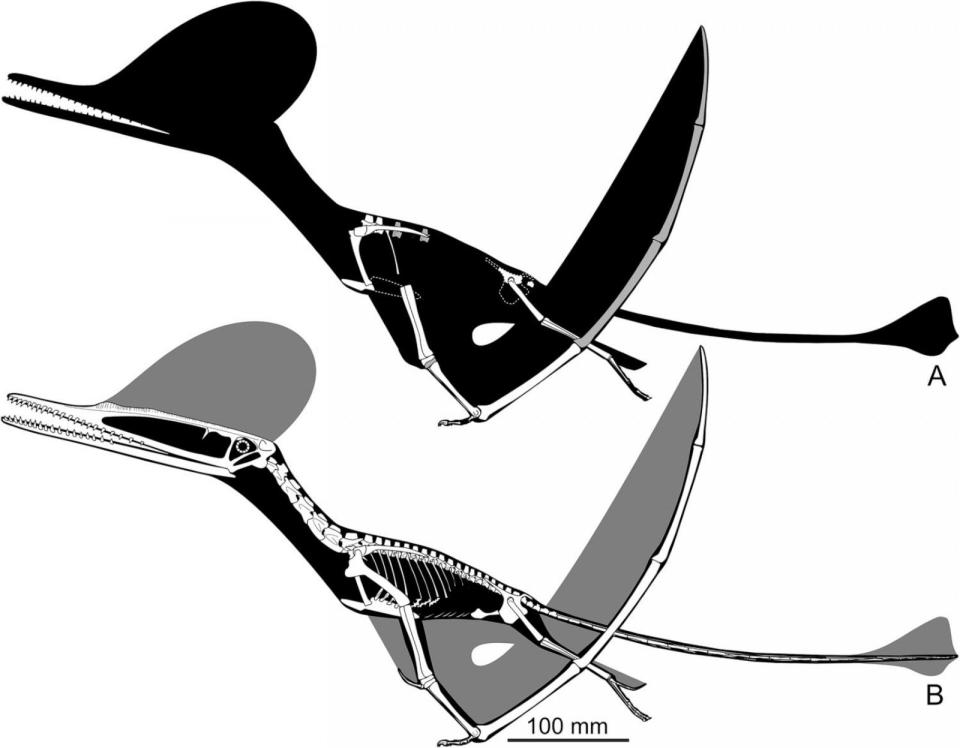New flying dinosaur skeleton discovered on Isle of Skye in Scotland
Over 166 million years after its time roaming the Earth, scientists announced the discovery of a winged dinosaur skeleton that was found on the Isle of Skye in Scotland.
In findings published in the Journal of Vertebrate Paleontology on Feb. 5, researchers discovered the remains of a single pterosaur, named Ceoptera evansae, that's believed to have lived 166 to 168 million years ago during the Middle Jurassic period.
The research was led by scientists from the Natural History Museum, University of Bristol, University of Leicester and University of Liverpool.
MORE: New dinosaur discovery may be the closest relative to Tyrannosaurus rex, scientists say
Scientists report that Ceoptera evansae's incomplete fossil remains were first discovered in 2006 on a small beach along the coastline of Loch Scavaig, on the Strathaird Peninsula in the Isle of Skye.

Since then, researchers analyzed partial skeletons – remains of the shoulders, wings, legs and backbone – and used digital scanning to reveal multiple elements of the skeleton that were "otherwise inaccessible" due to being embedded in rock.
The skeleton of Ceoptera evansae is among the first of a pterosaur species to be fully digitally prepared, according to the report.
In the findings, researchers say Ceoptera evansae hails from a group of pterosaurs known as Darwinoptera, which were believed to mainly live in China, where the species' fossils have been discovered before.

Making the discovery in Scotland has led researchers to suggest the Darwinoptera may have lived 25 million years longer than previously understood – from the Early Jurassic period to the latest Jurassic -- and gives insight into the diversity of the species.
MORE: New dinosaur, a species of spinosaurid, discovered in Spain, researchers say
The pterosaur species is among the earliest vertebrates known to have evolved to be able to fly and this new analysis indicates the species lived alongside avialans, the dinosaur species believed to evolve into modern birds.
Professor Paul Barrett, merit researcher at the Natural History Museum and senior author on the paper said in a press release for the paper that the discovery of this species in the UK was a "complete surprise."
"Ceoptera helps to narrow down the timing of several major events in the evolution of flying reptiles. Its appearance in the Middle Jurassic of the UK was a complete surprise, as most of its close relatives are from China," Barrett said. "It shows that the advanced group of flying reptiles to which it belongs appeared earlier than we thought and quickly gained an almost worldwide distribution."

Dr Liz Martin-Silverstone, a palaeobiologist from the University of Bristol and lead author on the paper, said the findings brings researchers "one step closer to understanding" the evolution of pterosaurs.
"The time period that Ceoptera is from is one of the most important periods of pterosaur evolution, and is also one in which we have some of the fewest specimens, indicating its significance," Martin-Silverstone said in the press release. "To find that there were more bones embedded within the rock, some of which were integral in identifying what kind of pterosaur Ceoptera is, made this an even better find than initially thought. It brings us one step closer to understanding where and when the more advanced pterosaurs evolved."
New flying dinosaur skeleton discovered on Isle of Skye in Scotland originally appeared on abcnews.go.com

 Yahoo News
Yahoo News 
